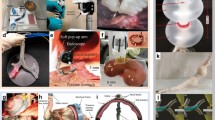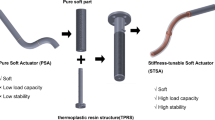Abstract
Background
Minimally invasive surgery attracts more and more attention because of the advantages of minimal trauma, less bleeding and pain and low complication rate. However, minimally invasive surgery for beating hearts is still a challenge. Our goal is to develop a soft robot surgical system for single-port minimally invasive surgery on a beating heart.
Materials and methods
The soft robot described in this paper is inspired by the octopus arm. Although the octopus arm is soft and has more degrees of freedom (DOFs), it can be controlled flexibly. The soft robot is driven by cables that are embedded into the soft robot manipulator and can control the direction of the end and middle of the soft robot manipulator. The forward, backward and rotation movement of the soft robot is driven by a propulsion plant. The soft robot can move freely by properly controlling the cables and the propulsion plant. The soft surgical robot system can perform different thoracic operations by changing surgical instruments. To evaluate the flexibility, controllability and reachability of the designed soft robot surgical system, some testing experiments have been conducted in vivo on a swine.
Results
Through the subxiphoid, the soft robot manipulator could enter into the thoracic cavity and pericardial cavity smoothly and perform some operations such as biopsy, ligation and ablation. The operations were performed successfully and did not cause any damage to the surrounding soft tissues. From the experiments, the flexibility, controllability and reachability of the soft robot surgical system have been verified. Also, it has been shown that this system can be used in the thoracic and pericardial cavity for different operations.
Conclusions
Compared with other endoscopy robots, the soft robot surgical system is safer, has more DOFs and is more flexible for control. When performing operations in a beating heart, this system maybe more suitable than traditional endoscopy robots.








Similar content being viewed by others
References
Rosen M, Ponsky J (2001) Minimally invasive surgery. Endoscopy 33:358–366
Cohn LH, Adams DH, Couper GS, Bichell DP, Rosborough DM, Sears SP et al (1997) Minimally invasive cardiac valve surgery improves patient satisfaction while reducing costs of cardiac valve replacement and repair. Ann Surg 226:421
Clark J, Noonan DP, Vitiello V, Sodergren MH, Shang J, Payne CJ et al (2014) A novel flexible hyper-redundant surgical robot: prototype evaluation using a single incision flexible access pelvic application as a clinical exemplar. Surg Endosc 29:658–667
Patel N, Seneci CA, Shang J, Leibrandt K, Yang GZ, Darzi A et al (2015) Evaluation of a novel flexible snake robot for endoluminal surgery. Surg Endosc 29(11):3349–3355. doi:10.1007/s00464-015-4088-y
Son J, Cho CN, Kim KG, Chang TY, Jung H, Kim SC et al (2015) A novel semi-automatic snake robot for natural orifice transluminal endoscopic surgery: preclinical tests in animal and human cadaver models (with video). Surg Endosc 29(6):1643–1647
Kimura T, Miyoshi S, Takatsuki S, Tanimoto K, Fukumoto K, Soejima K et al (2011) Safety and efficacy of pericardial endoscopy by percutaneous subxyphoid approach in swine heart in vivo. J Thorac Cardiovasc Surg 142(1):181–190
Palep JH (2009) Robotic assisted minimally invasive surgery. J Min Access Surg 5(1):1
Degani A, Choset H, Wolf A, Zenati M (2006) Highly articulated robotic probe for minimally invasive surgery. In: Proceedings of the 2006 IEEE international conference on robotics and automation, pp 167–4172
Hiroki C, Tames JG, Yu W (2012) A cable driven robot with integrated suction cups for NOTES support. Trans Control Mech Syst 1(1):6–12
Degani A, Choset H, Zubiate B, Ota T, Zenati M et al (2008) Highly articulated robotic probe for minimally invasive surgery. In: 30th annual international conference of the engineering in medicine and biology society. IEEE, pp 3273–3276
Ota T, Degani A, Schwartzman D, Zubiate B, McGarvey J, Choset H, Zenati MA (2009) A highly articulated robotic surgical system for minimally invasive surgery. Ann Thorac Surg 87(4):1253–1256
Pfeifer R, Lungarella M, Iida F (2007) Self-organization, embodiment, and biologically inspired robotics. Science 318(5853):1088–1093
Iida F, Laschi C (2011) Soft robotics: challenges and perspectives. Proc Comput Sci 7:99–102
Kanagaratnam P, Koa-Wing M, Wallace DT, Goldenberg AS, Peters NS, Davies DW (2008) Experience of robotic catheter ablation in humans using a novel remotely steerable catheter sheath. J Interv Card Electr 21(1):19–26
Wang H, Wang C, Chen W, Liang X, Liu Y (2016) Three dimensional dynamics for cable-driven soft manipulator. IEEE/ASME Trans Mechatron. doi:10.1109/TMECH.2016.2606547
Wang H, Zhang R, Chen W, Liang X, Pfeifer R (2016) Shape detection algorithm for soft manipulator based on fiber bragg gratings. IEEE/ASME Trans Mechatron. doi:10.1109/TMECH.2016.2606491
Wang H, Yang B, Liu Y, Chen W, Liang X, Pfeifer R (2016) Visual servoing of soft robot manipulator in constrained environments with an adaptive controller. IEEE/ASME Trans Mechatron. doi:10.1109/TMECH.2016.2613410
Acknowledgements
This work was supported in part by Natural Science Foundation of China under Grant 61473191 and in part by State Key Laboratory of Robotics and System (HIT).
Author information
Authors and Affiliations
Corresponding authors
Ethics declarations
Disclosures
Hesheng Wang, Runxi Zhang, Weidong Chen, Xiaozhou Wang and Rolf Pfeifer have no conflicts of interest or financial ties to disclose.
Rights and permissions
About this article
Cite this article
Wang, H., Zhang, R., Chen, W. et al. A cable-driven soft robot surgical system for cardiothoracic endoscopic surgery: preclinical tests in animals. Surg Endosc 31, 3152–3158 (2017). https://doi.org/10.1007/s00464-016-5340-9
Received:
Accepted:
Published:
Issue Date:
DOI: https://doi.org/10.1007/s00464-016-5340-9




